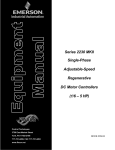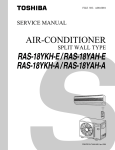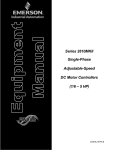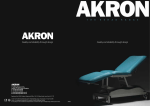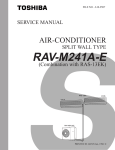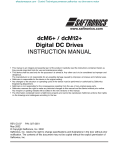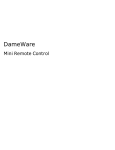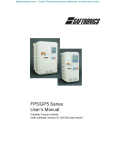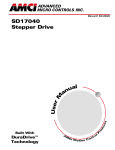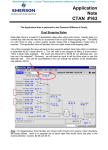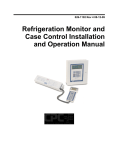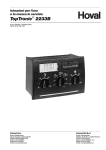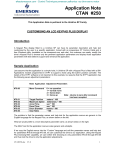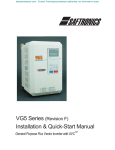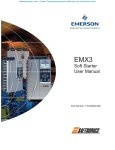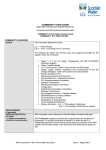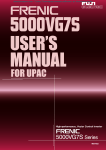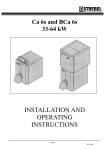Download 1/6 – 5 HP - Efes otomasyon
Transcript
efesotomasyon.com - Control Techniques,emerson,saftronics -ac drive-servo motor Series 2230 MKII Single-Phase Adjustable-Speed Regenerative DC Motor Controllers (1/6 – 5 HP) Control Techniques 3750 East Market Street York, PA 17402-2798 717-751-4200, FAX 717-751-4263 www.fincor.net BOOK 0960-B efesotomasyon.com - Control Techniques,emerson,saftronics -ac drive-servo motor efesotomasyon.com - Control Techniques,emerson,saftronics -ac drive-servo motor BOOK 0960-B SERIES 2230 MKII SINGLE-PHASE ADJUSTABLE-SPEED REGENERATIVE DC MOTOR CONTROLLERS (1/6 - 5 HP) Control Techniques York Drive Center 3750 E Market Street York, PA 17402-2798 USA Tel 717.751.4200 Fax 717.751.4263 www.fincor.net efesotomasyon.com - Control Techniques,emerson,saftronics -ac drive-servo motor BOOK 0960-B efesotomasyon.com - Control Techniques,emerson,saftronics -ac drive-servo motor BOOK 0960-B TABLE OF CONTENTS SECTION TITLE PAGE I .......................................... GENERAL INFORMATION ...................................................................1 Introduction ...............................................................................................1 General Description...................................................................................1 Motor Selection .........................................................................................1 Description of Operation ...........................................................................1 Model Types..............................................................................................2 II.......................................... INSTALLATION......................................................................................3 Installation Guidelines...............................................................................3 Installing the Controller ............................................................................5 Initial Startup...........................................................................................16 III ......................................... OPERATION ..........................................................................................17 Power On/Off ..........................................................................................17 Run ..........................................................................................................17 Stop .........................................................................................................17 Controlled Stop .......................................................................................17 Zero Speed Detection ..............................................................................17 Speed Control..........................................................................................18 Torque Control ........................................................................................18 Jog ...........................................................................................................19 Reverse ....................................................................................................19 Armature Voltage and Current Outputs ..................................................19 Load Monitor (Motor Timed Overload)..................................................20 Direction Output......................................................................................20 Speed Regulator Input.............................................................................20 Inoperative Motor....................................................................................20 IV ......................................... MAINTENANCE AND REPAIR...........................................................21 General ....................................................................................................21 Adjustment Instructions ..........................................................................21 Troubleshooting Instructions...................................................................23 V.......................................... PARTS LIST ...........................................................................................27 VI ......................................... RATINGS AND SPECIFICATIONS .....................................................29 Ratings.....................................................................................................29 Operating Conditions ..............................................................................30 Performance Characteristics....................................................................31 Adjustments.............................................................................................31 Specifications ..........................................................................................31 VII ........................................ DRAWINGS ...........................................................................................33 INDEX ....................................................................................................36 iii efesotomasyon.com - Control Techniques,emerson,saftronics -ac drive-servo motor BOOK 0960-B LIST OF TABLES TABLE TITLE PAGE 1................... Series 2230 MKII Model Matrix...........................................................................................2 2................... Jumper J4 Position........................................................................................................................5 3.................... Dip Switch (SW3) ........................................................................................................................6 4.................... Initial Potentiometer Settings .....................................................................................................16 5.................... Dynamic Braking Characteristics ..............................................................................................18 6.................... Troubleshooting.................................................................................................................... 23-26 7.................... Parts List, Series 2230 MKII Controllers ..................................................................................27 8.................... Typical Application Data ...........................................................................................................29 9.................... Operating Voltages and Signals.................................................................................................30 10................... Controller Weights .....................................................................................................................30 11................... Speed Regulation Characteristics...............................................................................................31 12................... Shunt Field Data .........................................................................................................................32 13................... Tachometer Feedback Voltage Selection ..................................................................................22 LIST OF ILLUSTRATIONS FIGURE TITLE PAGE 1................... Controller Mounting Configurations .....................................................................................7 2................... Controller Mounting Dimensions ................................................................................................8 3.................... Logic Connection Diagram, Run-Stop-Jog Switch.....................................................................9 4.................... Logic Connection Diagram, Forward-Reverse Switch and Run-Stop-Jog Switch ....................9 5.................... Logic Connection Diagram, Run-Stop-Controlled Stop Pushbuttons and Run-Jog Switch....10 6.................... Logic Connection Diagram, Run-Stop-Controlled Stop Pushbuttons and Forward / Reverse Switch . .........................................................................................................................10 7.................... Logic Connection Diagram, Optional Contactor Using Run-Stop-Jog Switch........................11 8.................... Logic Connection Diagram, Optional Contactor Using Run-Stop Pushbuttons and ...............11 Run-Jog Switch 9.................... Logic Connection Diagram, Line Starting With Motor Speed Potentiometer .........................12 10................... Signal Connection Diagram, Motor Speed Potentiometer, Unidirectional ..............................12 11................... Signal Connection Diagram, Motor Speed Potentiometer, Bidirectional.................................13 12................... Signal Connection Diagram, Tachometer Feedback.................................................................13 13................... Signal Connection Diagram, External Current (Torque) Reference Potentiometer.................13 14................... Signal Connection Diagram, External Current Limit Potentiometers ......................................14 15................... Signal Connection Diagram, Line Starting Without a Motor Speed Potentiometer ................14 16................... Signal Connection Diagram, External PID Controller with Auto/Manual Switch ..................14 17................... Signal Connection Diagram, 4-20mA Outputs – Armature Amps and Volts..........................15 18................... Signal Connection Diagram, 0-±10Vdc Outputs – Armature Amps and Volts .......................15 19................... Functional Schematic, Series 2230 MKII..................................................................................34 20................... Series 2230 MKII Control Board, 1/6 – 3HP ............................................................................35 21................... 2233 MKII Connection Terminals - 5HP..................................................................................36 iv efesotomasyon.com - Control Techniques,emerson,saftronics -ac drive-servo motor BOOK 0960-B Blank Page v efesotomasyon.com - Control Techniques,emerson,saftronics -ac drive-servo motor BOOK 0960-B WARNING The following must be strictly adhered to at all times. 1. YOU AS THE OWNER OR OPERATOR OF FINCOR EQUIPMENT HAVE THE RESPONSIBILITY TO HAVE THE USERS OF THIS EQUIPMENT TRAINED IN ITS OPERATIONS AND WARNED OF ANY POTENTIAL HAZARDS OF SERIOUS INJURY. 2. THE DRIVE EQUIPMENT SHOULD BE INSTALLED, OPERATED, ADJUSTED, AND SERVICED ONLY BY QUALIFIED PERSONNEL FAMILIAR WITH THE CONSTRUCTION AND OPERATION OF THE EQUIPMENT AND THE HAZARDS INVOLVED INCLUDING THOSE DESCRIBED BELOW. FAILURE TO OBSERVE THIS WARNING CAN RESULT IN PERSONAL INJURY, LOSS OF LIFE, AND PROPERTY DAMAGE. 3. THE NATIONAL ELECTRICAL CODE REQUIRES THAT AN AC LINE FUSED DISCONNECT OR CIRCUIT BREAKER BE PROVIDED IN THE AC INPUT POWER LINES TO THE CONTROLLER. THIS DISCONNECT MUST BE LOCATED WITHIN SIGHT OF THE CONTROLLER. DO NOT OPERATE THE CONTROLLER UNTIL THIS CODE REQUIREMENT HAS BEEN MET. 4. THE DRIVE EQUIPMENT IS AT AC LINE VOLTAGE WHENEVER AC POWER IS CONNECTED TO THE DRIVE EQUIPMENT. CONTACT WITH AN ELECTRICAL CONDUCTOR INSIDE THE DRIVE EQUIPMENT OR AC LINE DISCONNECT CAN CAUSE ELECTRIC SHOCK RESULTING IN PERSONAL INJURY OR LOSS OF LIFE. 5. BE SURE ALL AC POWER IS DISCONNECTED FROM THE DRIVE EQUIPMENT BEFORE TOUCHING ANY COMPONENT, WIRING, TERMINAL, OR ELECTRICAL CONNECTION IN THE DRIVE EQUIPMENT. 6. ALWAYS WEAR SAFETY GLASSES WHEN WORKING ON THE DRIVE EQUIPMENT. 7. DO NOT REMOVE OR INSERT CIRCUIT BOARDS, WIRES, OR CABLES WHILE AC POWER IS APPLIED TO THE DRIVE EQUIPMENT. FAILURE TO OBSERVE THIS WARNING CAN CAUSE DRIVE DAMAGE AND / OR PERSONAL INJURY. 8. ALL DRIVE EQUIPMENT ENCLOSURES, MOTOR FRAMES, AND REMOTE OPERATOR STATIONS MUST BE CONNECTED TO AN UNBROKEN COMMON GROUND CONDUCTOR. AN UNBROKEN GROUNDING CONDUCTOR MUST BE RUN FROM THE COMMON GROUND CONDUCTOR TO A GROUNDING ELECTRODE BURIED IN THE EARTH OR ATTACHED TO A PLANT GROUND. REFER TO THE NATIONAL ELECTRICAL CODE AND LOCAL CODES FOR GROUNDING REQUIREMENTS. 9. THE ATMOSPHERE SURROUNDING THE DRIVE EQUIPMENT MUST BE FREE OF COMBUSTIVE VAPORS, CHEMICAL FUMES, OIL VAPOR, AND ELECTRICALLY CONDUCTIVE OR CORROSIVE MATERIALS. 10. SOLID-STATE DEVICES IN THE CONTROLLER CAN BE DESTROYED OR DAMAGED BY STATIC ELECTRICITY. THEREFORE, PERSONNEL WORKING NEAR THESE STATICSENSITIVE DEVICES MUST BE APPROPRIATELY GROUNDED. vi efesotomasyon.com - Control Techniques,emerson,saftronics -ac drive-servo motor BOOK 0960-B SECTION I GENERAL INFORMATION INTRODUCTION This manual contains installation, operation, and maintenance and repair instructions for Fincor Series 2230 MKII Single-Phase Adjustable-Speed Regenerative DC Motor Controllers. A parts list, ratings and specifications, and drawings are also included. GENERAL DESCRIPTION Series 2230 MKII Controllers statically convert AC line power to regulated DC for adjustable-speed armature control of shunt-wound and permanent-magnet motors. Applications include those requiring controllable bi-directional torque for overhauling loads, contactor-less reversing, and position control. Series 2230 MKII Controllers comply with applicable standards established by the National Electrical Code and NEMA for motor and industrial control equipment. The controllers are Underwriters Laboratories Listed (File No. E184521) UL/cUL. MOTOR SELECTION Series 2230 MKII Controllers control the operation of general purpose DC motors designed for use with solid-state rectified power supplies. The motor may be shunt-wound, stabilized shunt-wound, or permanent magnet. For maximum efficiency, the motor should be rated for operation from a NEMA Code K power supply. DESCRIPTION OF OPERATION Series 2230 MKII Regenerative Controllers, also known as four-quadrant controllers, not only control motor speed and direction of rotation, but also the direction of motor torque. Referring to Figure 1, when the drive (controller and motor) is operating in Quadrants I and III, motor rotation and torque are in the same direction and the drive functions as a conventional non-regenerative drive. In Quadrants II and IV, motor torque opposes the direction of motor rotation, which results in controlled braking. The drive can switch rapidly from motoring to braking modes while simultaneously controlling the direction of motor rotation. Under braking conditions, the controllers convert the mechanical energy of the motor and connected load into electrical energy, which is returned (regenerated) to the AC power source. FIGURE 1. Four-Quadrant Operation 1 efesotomasyon.com - Control Techniques,emerson,saftronics -ac drive-servo motor BOOK 0960-B MODEL TYPES TABLE 1. SERIES 2230 MKII MODEL MATRIX a FUNCTION CONFIGURATION OPERATOR CONTROLS POWER SOURCE & HP RANGE MODEL RUN/STOP JOG b SWITCH ARMATURE CONTACT c AND DB 2231 OPEN CHASSIS X X X X X X 2232 2232B X 2236 2236B X 2233 2233B X 2233P0 2233P1 a. b. c. X X X X 1/6 -1 1/3 - 2 1/6 - 1 1/3 - 3 1/2 - 2 1-5 X X X X X X X X X X X X X X X X X 2233BP0 2233BP1 X X 2235B 230V X X X 2235 115V X X 2231BP0 REMOTE X X 2231P0 2231BP1 LOCAL INTEGRAL X 2231B 2231P1 ENCLOSED X X X X X Units are reconnectable No armature contactor Includes armature contactor 2 X X X X efesotomasyon.com - Control Techniques,emerson,saftronics -ac drive-servo motor BOOK 0960-B SECTION II INSTALLATION Before starting the installation, read this section thoroughly. In addition, a thorough review of the Ratings and Specifications (Section VI) is recommended. The following installation guidelines should be kept in mind when installing the controller. INSTALLATION GUIDELINES 1. CONTROLLER MOUNTING - The controller may be mounted either vertically or horizontally. However, never mount the controller upside down, immediately beside or above heat generating equipment, or directly below water or steam pipes. The controller must be mounted in a location free of vibration. Multiple controllers may be mounted side by side, as close to each other as the mounting feet will allow. The minimum clearance at the top and bottom of the controller may be as narrow as the conduit fittings allow. 2. ATMOSPHERE - The atmosphere surrounding the controller must be free of combustible vapors, chemical fumes, oil vapor, and electrically conductive or corrosive materials. The air surrounding an enclosed controller must not exceed 40 degrees C (104 degrees F), and the air surrounding an open-chassis controller must not exceed 55 degrees C (131 degrees F). Minimum air temperature is 0 degree C (32 degrees F) for enclosed and open-chassis controllers. 3. CONTROLLER CONSTRUCTION - Enclosed controllers are totally enclosed, non-ventilated, and comply with NEMA Type 4 and 12 standards. There is an oil resistant synthetic rubber gasket between the cover and base. Those models with integral operator controls include flexible boots to seal the switches, and a seal for the MOTOR SPEED potentiometer. Model 2235MKII and 2236MKII controllers are unenclosed open-chassis units with the printed wiring board mounted on an aluminum bracket. The small controller base is made of die-cast aluminum with a powdered epoxy finish, and the cover is made of a diecast aluminum alloy. The larger controller base is made of extruded aluminum and the cover is made of Noryl®, a strong engineering plastic with outstanding mechanical, thermal, and electrical properties. 4. LINE SUPPLY - The controller should not be connected to a line supply capable of supplying more than 5,000 amperes short-circuit current. Short-circuit current can be limited by using an input supply transformer of 50 KVA or less, or by using correctly sized current limiting fuses in the supply line ahead of the controller. Do not use a transformer with less than the minimum transformer KVA listed in Table 8, page 29. If rated line voltage is not available, a line transformer will be required. If the line supply comes directly from a transformer, place a circuit breaker or disconnect switch between the transformer secondary and the controller. If power is switched in the transformer primary, transients may be generated which can damage the controller. See Table 8 (page 29) for minimum transformer KVA. Do not use power factor correction capacitors on the supply line to the controller. A 20 Joule metal oxide varistor (MOV) is connected across the controller terminals. If higher energy transients are present on the line supply, additional transient suppression will be required to limit transients to 150% of peak line voltage. 3 efesotomasyon.com - Control Techniques,emerson,saftronics -ac drive-servo motor BOOK 0960-B When a 115 VAC line supply is used, connect the white (common) wire to Terminal L2 and connect the remaining (hot) wire to Terminal L1. 5. ISOLATION TRANSFORMER - While not required, an isolation transformer can provide the following advantages: a. Reduce the risk of personal injury if high voltage drive circuits are accidentally touched. b. Provide a barrier to externally generated AC supply transients. This can prevent controller damage from abnormal line occurrences. c. Reduce the potential for damaging current if the motor armature, motor field, or motor wiring becomes grounded. 6. GROUNDING - Connect the green or bare (ground) wire of the line supply to the ground screw located near the top conduit entry hole in the controller base. Then ground the controller base by connecting the ground screw to earth ground. The motor frame and operator control stations must also be grounded. Personal injury may occur if the controller, motor, and operator stations are not properly grounded. 7. WIRING PRACTICES - The power wiring must be sized to comply with the National Electrical Code, CSA, or local codes. Refer to the controller data label for line and motor current ratings. Do not use solid wire. Signal wiring refers to wiring for potentiometers, tachometer generators, and transducers. Control wiring refers to wiring for operator controls, e.g., switches and pushbuttons. Signal and control wiring may be run in a common conduit, but not in the same conduit as the power wiring. In an enclosure, signal and control wiring must be kept separated from power wiring and only cross at a 90 degree angle to reduce electrical noise. If shielded wire (such as Alpha 2422 - two conductor, 2423 - three conductor, 2424 - four conductor) is used for the signal and control wiring, connect the shields to chassis ground (ground screw on the controller base) and tape the opposite ends of the shields. Twisted cable is also suitable for signal and control wiring. The small base models provide two 3/4-14 NPT threaded holes for conduit entry, one each in the top and bottom of the controller. The large base models provide two 3/4 inch conduit entry for the power in and out wiring, and one 1/2 inch conduit entry for signal wiring. 4 efesotomasyon.com - Control Techniques,emerson,saftronics -ac drive-servo motor BOOK 0960-B INSTALLING THE CONTROLLER 1. Remove the controller front cover (if used) by removing the four cover screws. 2. Check components in the controller for shipping damage. Report shipping damage to the carrier. 3. Check the controller and motor data labels to be sure the units are electrically compatible. 4. Be sure the controller has been calibrated correctly for the motor being used. The initial calibration is performed by changing the position of a Jumper J4 on the controller control board to comply with Table 2. To change the position of Jumper J4, pull the jumper from the control board and then push it onto the appropriate two pins on the board. Select the position closest, but not less then, the motor nameplate armature current rating. The final calibration can be fined tuned, if needed, by the current limit potentiometer. For the location of J4 and the current limit potentiometer, see Figure 20 (page 35). TABLE 2. JUMPER J4 POSITION MOTOR ARMATURE CURRENT RATING (AMPERES) JUMPER a POSITION 100% 80% 60% 40% 20% 2231 - 2235 2 HP Maximum 2232 - 2236 3 HP Maximum 2233 5 HP Maximum 10 8 6 4 2 15 12 9 6 3 25 20 15 10 5 5. Check the positions of Jumpers J1, J2, and J3 on the control board. For the locations of J1, J2, and J3, see Figure 20, page 35. For a 230 VAC line supply and a 180V armature motor, Jumper J1 must be in the 230V position, and Jumpers J2 and J3 must be in the 180V position. For a 115 VAC line supply and a 90V armature motor, J1 must be in the 115V position, and J2 and J3 must be in the 90V position. To change the position of J1, J2, or J3 pull the jumper from the control board and then push it onto the appropriate pins on the board. NOTE: If Option 1001 (Armature Contactor), or 1775 (Signal Interface) is to be installed in the controller, do not offset the five-position plug (supplied with the option) at Connector J1 on the control board. Do not confuse Connector J1 with Jumper J1. Refer to the Instruction Sheet (ISP0703, ISP0653, respectively) supplied with the option for connection instructions. 6. If the controller is to operate from a 50 Hz supply, set segment 6 of the DIP Switch (SW3) to the “OFF” position on the controller control board. For the location of DIP Switch SW3, see Figure 20, page 35. 7. The controller may be surface mounted or panel mounted as shown in Figure 1, page 7. Mount the controller. Mounting dimensions are shown in Figure 2, page 8. 8. Conduit entry is made by punching out the knockout at the top or bottom of the controller base. To prevent component damage from knockout fragments, apply masking tape to the inside of the knockout before punching. 9. Connect the power wiring to Terminals L1, L2, A1, A2, F+ and F-. Be sure to observe Installation Guidelines 4 and 7 on pages 3 and 4. If half-wave shunt field voltage is desired, connect one of the motor shunt field leads to Terminal L1 (see Table 12 on page 32). Note: Low inductance motors require a full-wave field to prevent current instability. 5 efesotomasyon.com - Control Techniques,emerson,saftronics -ac drive-servo motor BOOK 0960-B 10. If the controller contains any options that require external wiring, follow the wiring instructions in the instruction sheet supplied with the option. 11. If remote operator control wiring and/or signal wiring is required, connect the controller as shown in the appropriate connection diagram (Figures 3 through 18). Figures 3 through 9 show operator control connections, and Figures 10 through 18 show signal connections. 12. The controller can be programmed for various applications by throwing switches on dip switch SW3 TABLE 3. DIP SWITCH (SW3) FACTORY DEFAULT SETTING IS UNDERLINED Switch Position ON Selects anti-restart mode. Prevents controller from restarting automatically after an AC line power interruption. OFF Disables anti-restart mode. Used for line starting applications (jumper TB2:9 to TB2:8 to enable drive). ON Selects internal Forward current (torque) reference pot. OFF Selects use of an external Forward current (torque) reference pot. (Set internal Forward current limit pot at 100%) ON Adds ≈2% zero speed reference deadband to prevent motor creeping. OFF No zero speed deadband; enabled drive may creep with zero speed reference ON Selects torque regulator mode. OFF Selects speed regulator mode. ON Low voltage (3Vdc - 30Vdc) tachometer scaling OFF High voltage (31 Vdc - 175Vdc) tachometer scaling. ON Selects 60Hz line input frequency. OFF Selects 50Hz line input frequency. 1 2 3 4 5 6 7 ON OFF Selects internal Reverse current (torque) reference pot. Selects use of an external Reverse current (torque) reference pot. (Set internal Reverse current limit pot at 100%) 13. Install the controller cover, if used. 6 efesotomasyon.com - Control Techniques,emerson,saftronics -ac drive-servo motor BOOK 0960-B FIGURE 1. CONTROLLER MOUNTING CONFIGURATIONS BR1 - FWD G3 G1 G4 G2 G3 G1 G4 G2 BR2 - REV 2233 DRIVE FIGURE 2. CONTROLLER MOUNTING DIMENSIONS 7 efesotomasyon.com - Control Techniques,emerson,saftronics -ac drive-servo motor BOOK 0960-B FIGURE 2. CONTROLLER MOUNTING DIMENSIONS 8 efesotomasyon.com - Control Techniques,emerson,saftronics -ac drive-servo motor BOOK 0960-B Figure 3. Logic connection diagram, Run-Stop-Jog Switch Figure 4. Logic connection diagram, Forward-Reverse Switch and Run-Stop-Jog Switch 9 efesotomasyon.com - Control Techniques,emerson,saftronics -ac drive-servo motor BOOK 0960-B Figure 5. Logic connection diagram, Run-Stop Controlled Stop Pushbuttons and Run-Jog Switch Figure 6. Logic connection diagram, Run-Stop-Controlled Stop Pushbuttons, Run-Jog Switch and Forward-Reverse Switch 10 efesotomasyon.com - Control Techniques,emerson,saftronics -ac drive-servo motor BOOK 0960-B Figure 7. Logic connection diagram, Optional Contactor using Run-Stop-Jog Switch Figure 8. Logic connection diagram, Optional Contactor using Run-Stop Pushbuttons and Run-Jog Switch 11 efesotomasyon.com - Control Techniques,emerson,saftronics -ac drive-servo motor BOOK 0960-B Figure 9. Logic connection diagram, Line Starting with Motor Speed Potentiometer Figure 10. Signal Connection Diagram, Motor Speed Potentiometer, Unidirectional 12 efesotomasyon.com - Control Techniques,emerson,saftronics -ac drive-servo motor BOOK 0960-B Figure 11. Signal Connection Diagram, Motor Speed Potentiometer, Bidirectional Figure 12. Signal Connection Diagram, Tachometer Feedback Figure 13. Signal Connection Diagram, External Current (Torque) Reference Potentiometer 13 efesotomasyon.com - Control Techniques,emerson,saftronics -ac drive-servo motor BOOK 0960-B Figure 14. Signal Connection Diagram, External Current Limit Potentiometers Figure 15. Signal Connection Diagram, Line Starting Without a Motor Speed Potentiometer Figure 16. Signal Connection Diagram, External PID Controller input with Auto/Manual Switch 14 efesotomasyon.com - Control Techniques,emerson,saftronics -ac drive-servo motor BOOK 0960-B Figure 17. Signal Connection Diagram, 4-20mA Outputs – Armature Amps and Volts Figure 18. Signal Connection Diagram, 0 to ±10V Outputs – Armature Amps and Volts 15 efesotomasyon.com - Control Techniques,emerson,saftronics -ac drive-servo motor BOOK 0960-B INITIAL STARTUP 1. Open the controller cover (if used) by removing the four cover screws. 2. Be familiar with all options installed in the controller by reviewing the instruction sheets supplied with the options. 3. Be sure all wiring is correct and all wiring terminations are tightened securely. 4. Be sure the controller is calibrated correctly. See steps 4 and 5 under “Installing the Controller” on page 5. Be sure the AC supply voltage to the controller agrees with the controller data label. 6. The potentiometers in the controller are factory adjusted as shown in Table 4. These settings will provide satisfactory operation for most applications. If different settings are required, refer to “Adjustment Instructions” starting on page 21 . TABLE 4. INITIAL POTENTIOMETER SETTINGS POTENTIOMETER SETTING DESCRIPTION ACCEL 1/3 Turn Clockwise 10 Seconds DECEL 1/3 Turn Clockwise 10 Seconds IR/TACH Fully Counterclockwise (0%) 0% Boost MAX SPD 3/4 Turn Clockwise 100% Speed FWD CUR LMT Fully Clockwise (100%) 150% Load REV CUR LMT Fully Clockwise (100%) 150% Load SPD STAB 1/2 Turn Clockwise Nominal Gain FWD CUR STAB 1/2 Turn Clockwise Nominal Gain REV CUR STAB 1/2 Turn Clockwise Nominal Gain 7. If the controller has a cover, place it on the controller and secure it with the four cover screws. 8. Turn-on the AC supply to the controller. 9. Check motor rotation, as follows: a. If a MOTOR SPEED potentiometer is used, turn it to zero on its dial. If an external signal is used for the speed reference, set it at minimum. b. If a RUN-STOP-JOG switch is used, place it in RUN position. Otherwise, initiate a Run command. c. Turn the MOTOR SPEED potentiometer clockwise or increase the speed reference signal, as applicable. To stop the motor, place the switch in STOP position or initiate a Stop command, as applicable. If the motor rotates in the wrong direction, turn-off the AC supply to the controller, and then interchange the motor armature leads at the motor connection box or at the controller terminal board. 10. Refer to Section III, “Operation” for operating instructions on page 17. 16 efesotomasyon.com - Control Techniques,emerson,saftronics -ac drive-servo motor BOOK 0960-B SECTION III OPERATION POWER ON/OFF To energize the drive, turn-on the AC supply voltage to the controller. When this occurs, the motor shunt field energizes with rated field voltage, and potentially hazardous voltage is present at the motor armature terminals. These voltages can cause electric shock resulting in personal injury or loss of life. If the AC supply is interrupted, and the controller is not set up for line starting, the motor will not restart when the AC supply is restored until the controller is reset by initiating a Stop command and then a Start command. If the controller is set up for line starting, and the AC supply is interrupted, the motor will restart when the AC supply is restored, provided the external AC line contactor is pulled in. RUN If a RUN-STOP-JOG switch is used, place the switch in RUN position. Otherwise, initiate a Run command. A Run command will accelerate the motor to the setting of the MOTOR SPEED potentiometer or external speed reference signal, as applicable. The rate of acceleration is preset by the ACCEL potentiometer on the controller control board. STOP If a RUN-STOP-JOG switch is used, place the switch in STOP position. Otherwise, initiate a Stop command. A Stop command will stop the motor at a rate proportional to the stopping rate of the motor load. If the controller has dynamic braking, the motor stopping time will be reduced. Dynamic braking provides exponential rate braking of the motor armature, which occurs when the circuit is opened between the controller and the motor armature, and one or more resistors connect across the motor armature. The dynamic braking resistors provide initial braking torque and stops per minute as shown in Table 5. CONTROLLED STOP Controlled stop is designed to be used with pushbutton (momentary) control, and should always include an emergency stop (coast) pushbutton to guarantee removal of the +24V control voltage from the enable input (TB2:8). When a controlled stop is initiated by momentarily applying +24V to TB2:12 input, the drive will decelerate the motor from set speed to zero speed at the Decel pot setting rate, and then drop out run relay K0 at zero speed (≈2% or less), determined by armature voltage. Note that if an overhauling load continues to rotate the motor above ≈2% speed, the zero speed detection circuit will not drop out K0. ZERO SPEED DETECTION The zero speed detection circuit used for controlled stop is also buffered and brought out to TB2:13 for use as an active low Zero Speed Output function (≈2% or less). The output is rated at 60V and 50ma @100°C, sufficient for switching 24Vdc loads (although the drive +24V power supply cannot supply this much customer current; it must be customer supplied). 17 efesotomasyon.com - Control Techniques,emerson,saftronics -ac drive-servo motor BOOK 0960-B TABLE 5. DYNAMIC BRAKING CHARACTERISTICS a COMPONENT BRAKING TORQUE (%) STOPS PER MINUTE a. MODEL 2231 2235 2232 2233 2231 2235 2232 2233 RATED VOLTAGE RATED HORSEPOWER 1/6 1/4 1/3 1/2 3/4 1 1-1/2 2 3 5 115V 180 129 103 66 44 34 NA NA NA NA 230V NA NA 400 278 190 130 88 62 NA NA 115V 300 215 170 110 75 60 NA NA NA NA 230V NA NA NA 400 320 220 145 105 85 96 115V 15 12 11 8 6 2 NA NA NA NA 230V NA NA 12 8 6 1 1 1 NA NA 115V 9 6 5 5 4 4 NA NA NA NA 230V NA NA NA 5 4 4 3 3 2 2 HIGH INERTIA LOADS MAY EXTEND BRAKING TIME AND CAUSE THE WATTAGE RATING OF THE DYNAMIC BRAKING RESISTORS TO BE EXCEEDED. An antiplug feature is included with optional Dynamic Braking. This feature prevents restarting the motor before the motor has braked to a stop. SPEED CONTROL Set Dip Switch SW3 position 4 to “OFF” (factory default). Motor speed is directly proportional to the setting of the MOTOR SPEED potentiometer or the magnitude of an external speed reference signal, as applicable. This potentiometer or the speed reference signal may be adjusted while the motor is running or may be preset before the motor is started. The rates of acceleration and deceleration are preset by the ACCEL and DECEL potentiometers, respectively, located on the controller control board. Maximum speed is preset by the MAX SPD potentiometer, located on the control board. TORQUE CONTROL Set Dip Switch SW3 position 4 to “ON”. Motor torque is directly proportional to the setting of the Forward and Reverse Current Limit potentiometers. A single torque reference input for an external torque signal or an external torque potentiometer may be set up by setting Dip Switch SW3 positions 2 and 7 to “OFF” and connecting the external torque signal to TB2 positions 5 and 6, or connecting an External Torque Reference potentiometer as shown in Figure 13 on page 13 . The internal Forward and Reverse current limit pots should be typically set at 100%, or can be used to trim the external Torque reference differently for Forward and Reverse torque (note, do not set either internal potentiometer below ≈40%). The external Torque potentiometer or the current reference signal may be adjusted while the motor is running or may be preset before the motor is started. Note that setting SW3 position 4 “ON” to select Torque Mode saturates the Speed Amplifier in the forward direction (A1 positive) and if the process demands less torque then the torque reference is commanding, motor speed will continue to increase up to maximum speed as set by the Max Speed potentiometer. 18 efesotomasyon.com - Control Techniques,emerson,saftronics -ac drive-servo motor BOOK 0960-B JOG If a RUN-STOP-JOG switch is used, place the switch in JOG position. Otherwise initiate a Jog command. Jog is momentary, causing motor rotation only while the switch is held in JOG position or while a Jog command is active. Release the switch to stop the motor. Normally, jog speed is directly proportional to the setting of the MOTOR SPEED potentiometer. If a separate JOG SPEED potentiometer is used, jog speed will be directly proportional to the setting of the JOG SPEED potentiometer. REVERSE When a bidirectional (zero center) MOTOR SPEED potentiometer is used, turning it in one direction past zero rotates the motor in a particular rotating direction at a speed directly proportional to the potentiometer setting. Turning the potentiometer in the opposite direction past zero rotates the motor in the opposite direction at a speed directly proportional to the potentiometer setting. If the motor is running when the potentiometer is turned in the opposite direction, the motor will first brake to a stop by means of regenerative braking before reversing rotation. When the potentiometer is in the center (zero) position, motor speed is zero. Note that motor may creep and if true zero speed is desired, enable Deadband by setting SW3 position 3 to “ON”. The rates of acceleration and deceleration (braking) are preset by the ACCEL and DECEL potentiometers, respectively, located on the controller control board. Maximum speed is preset by the MAX SPD potentiometer, located on the control board. Forward and reverse maximum speeds are identical. ARMATURE VOLTAGE AND CURRENT OUTPUTS In DC motors, armature voltage and armature current correspond to motor speed and motor load respectively. The drive armature voltage and current feedback signals are isolated, scaled, filtered, and buffered for use as output signals to other customer equipment such as follower and ratio applications or driving indicating meters, etc. Armature voltage is converted to a 0 to ±10Vdc (@2ma) output at TB2:17 and to a general purpose two-wire 4 to 20ma at TB2:15 and 16. Armature current is converted to a 0 to ±10Vdc (@2ma) output at TB2:21 and to a general purpose two-wire 4 to 20ma at TB2:19 and 20. The voltage outputs are bipolar and are positive (+10V @ 100% speed) for the forward direction (A1 positive) and negative (-10V @ 100% speed) for the reverse direction (A1 negative). The 4 to 20ma outputs are unipolar for either polarity of motor output voltage or current with the Direction Output available to indicate polarity, if needed. Note that 20ma equals 150% of rated motor output current, therefore, nominal 100% motor load current equals 14.7ma. Also note that diode arrays make the 4 to 20ma outputs insensitive to the external power supply polarity. The 4 to 20ma outputs must be external loop powered (≈8min to 36Vmax). 19 efesotomasyon.com - Control Techniques,emerson,saftronics -ac drive-servo motor BOOK 0960-B LOAD MONITOR UL approved as a motor protection device. The threshold for inverse timed overload will not exceed 120% of rated current and will shut down the drive (drop out K0) in about 60 seconds at 150% load current. The drive may be reset by cycling the enable line, or cycling input line power. Note that the timing capacitor is not reset by this, and that if the drive is immediately restarted into an overload, it will not take the full time to trip. DIRECTION OUTPUT The internal FORWARD direction command is buffered and brought out to TB2:18 for use as an active low output function. The output will be active low whenever running in the forward direction and off when running in the reverse direction. The output is rated at 60V and 50ma @100°C, sufficient for switching 24Vdc loads (although the drive +24V power supply cannot supply this much customer current; it must be customer supplied). SPEED REGULATOR INPUT The internal speed regulator input node is brought out to TB2:14 for typical use as an input from an external PID process controller. This input bypasses the accel/decel ramps to provide quicker response then using the standard speed reference input. INOPERATIVE MOTOR If the motor stops and/or won’t start, turn-off the AC supply to the controller, remove the controller cover (if used), and check the AC line fuse on the controller control board. For the location of the fuse, see Figure 20 or 21, page 35/36. If the fuse is blown, refer to the Troubleshooting Table (Table 6). 20 efesotomasyon.com - Control Techniques,emerson,saftronics -ac drive-servo motor BOOK 0960-B SECTION IV MAINTENANCE AND REPAIR GENERAL 1. Keep the controller dry and free of dust, dirt, and debris. No parts require periodic replacement. 2. Periodically turn-off the AC line supply to the controller and check all wire terminations to be sure they are tight. 3. Visually check components for damage due to overheating or breakage. All damaged and/or faulty components must be replaced for satisfactory operation. 4. Maintain the motor according to maintenance instructions supplied by the motor manufacturer. ADJUSTMENT INSTRUCTIONS ACCELERATION 1. Set the MOTOR SPEED potentiometer at 100% or the external speed reference signal at maximum, as applicable. 2. Initiate a Run command and observe the time required for the motor to reach maximum speed. 3. Adjust the ACCEL potentiometer for the desired rate. Full counter clockwise rotation is the fastest acceleration (0.1 second), and full clockwise rotation is the slowest acceleration (30 seconds). DECELERATION 1. With the motor running at maximum speed, quickly reset the MOTOR SPEED potentiometer to zero, or quickly decrease the speed reference signal to minimum, as applicable, and observe the time required for the motor to reach minimum speed. 2. Adjust the DECEL potentiometer for the desired rate. Full counter clockwise rotation is the fastest deceleration (0.1 second), and full clockwise rotation is the slowest deceleration (30 seconds). IR COMPENSATION IR compensation is used only for armature feedback. The IR/COMP potentiometer is factory set at zero (full counterclockwise rotation) for satisfactory operation with most motors. If improved speed regulation is desired, readjust IR compensation as follows: 1. If the motor is shunt-wound, run it at rated base speed. If the motor is a permanent-magnet type, run it at about 1/3 speed. 2. Turn the IR/COMP potentiometer clockwise slowly until motor speed becomes unstable. Then turn the potentiometer counterclockwise until motor speed stabilizes. MAXIMUM SPEED The MAX SPD potentiometer is factory set to provide 90 VDC armature voltage with a 115 VAC line, or 180 VDC armature voltage with a 230 VAC line. To readjust maximum speed, run the motor at maximum speed and adjust the MAX SPD potentiometer for the desired maximum speed. NOTE: If the MAX SPD potentiometer is turned too far counterclockwise, speed instability may occur. 21 efesotomasyon.com - Control Techniques,emerson,saftronics -ac drive-servo motor BOOK 0960-B CURRENT LIMIT 1. Turn the FWD CUR LMT and REV CUR LMT potentiometers fully clockwise (100%) to limit motor armature current at 150% of rated (factory default). 2. Turn the FWD CUR LMT and REV CUR LMT potentiometers counterclockwise as required to reduce maximum motor armature current. Notes: a. The GREEN power on LED indicator will change to RED whenever the controller is limiting (or regulating) current to the motor. b. External 10K ohm Current (Torque) Limit potentiometers can be used as shown in Figure 14 on page 14. If an external Forward Current (Torque) Limit potentiometer is desired, Segment 2 of DIP Switch SW3 must be in “OFF” (open position). If an external Reverse Current (Torque) Limit potentiometer is desired, Segment 7 of DIP Switch SW3 must be in “OFF” (open position). SPEED AND CURRENT STABILITY Potentiometer R152 (VOLTSTAB) provides gain adjustment to the speed (voltage) amplifier while potentiometers R153 (F CURSTAB) and R154 (R CURSTAB) provide gain adjustments to the torque (current) amplifiers. An increase in gain (clockwise) speeds up response, although excessive gain may cause unstable speed or vibrations, while a decrease in gain (counterclockwise) will slow down or delay the response, which may be needed for some processes. Best response for a given process can be achieved while monitoring the armature voltage and current output signals at TB2 17 and 21 respectively with an oscilloscope and making adjustments to minimize overshoot and undershoot while commanding speed or torque changes. TACHOMETER FEEDBACK SETUP 1. Before connecting or configuring tachometer feedback, follow the instructions to install and perform initial startup, then run drive with maximum input speed reference and adjust the MAX SPEED potentiometer (R10b) for the desired maximum motor speed. Note that for best performance, this should be within +/-20% of the motor nameplate maximum speed or stability problems may occur. 2. Connect the tachometer wires to TB2:7 (+ for forward) and 1 (common) and move the one piece jumper on J6 and J7 from the ARM position to the TACH position (Figure 20 on page 35). 3. Select the tachometer voltage scaling at max speed by dip switch SW3:5 as follows: TABLE 13. TACHOMETER FEEDBACK VOLTAGE SELECTION TACH VOLTAGE SW3:5 8Vdc - 30Vdc ON 31Vdc - 175 Vdc OFF 4. Adjust the IR/TACH MAX SPEED potentiometer fully clockwise, this will provide minimum speed with tachometer feedback. 5. Run the motor with maximum speed reference and start adjusting the IR/TACH MAX SPEED potentiometer counterclockwise until motor speed increases to the desired maximum speed with tachometer feedback. If the motor is not controllable, check for incorrect tachometer feedback voltage polarity. Note that if the tachometer signal is lost, the drive will automatically revert back to armature feedback. 22 efesotomasyon.com - Control Techniques,emerson,saftronics -ac drive-servo motor BOOK 0960-B TROUBLESHOOTING TABLE 6. TROUBLESHOOTING INDICATION 1. Motor won’t start (See “Inoperative Motor,” page 20) 2. Controller line fuse blows when AC line power is applied to the controller POSSIBLE CAUSE CORRECTIVE ACTION AC line open Be sure rated AC line voltage is applied to the controller. Operator controls inoperative or connected incorrectly Repair accordingly. Controller not reset Initiate a Stop command and then a Start command. Line Voltage Selection Jumper J1 in wrong position See Step 5 on page 5 under, “Installing The Controller.” Controller not enabled Be sure +24 VDC is applied to Terminal TB2 8. Loss of speed reference signal Check for 0 - ±10 VDC speed reference signal. Controller not adjusted correctly See Adjustment Instructions, Section IV. DIP Switch SW3 not set correctly. See Table 3 on page 6. Current limit set too low. Turn FWD CUR LMT and REV CUR LMT potentiometers clockwise. Open shunt field winding or wiring to the motor shunt field, causing loss of torquea Check the motor shunt field and associated circuitry for a loose connection or a broken wire. Repair accordingly. Motor failure Repair or replace the motor. Control board failure Replace the control board. Wiring faulty or incorrect Check all external wiring terminating in the controller. Correct accordingly. Circuit, component, or wiring grounded Remove ground fault. Two or more SCR’s shorted Replace shorted SCR’s or the control board. Varistor RV1 shorted Replace RV1 or the control board. Shunt Field Diode D39, D40, D41, or a D42 shorted Replace shorted diode or the control board. a Motor shunt field shorted or grounded Repair or replace the motor. Control board failure Replace the control board. Cont’d on next page 23 efesotomasyon.com - Control Techniques,emerson,saftronics -ac drive-servo motor BOOK 0960-B TABLE 6. TROUBLESHOOTING INDICATION 3. Controller line fuse blows when a Start command is initiated POSSIBLE CAUSE CORRECTIVE ACTION One SCR shorted Replace shorted device or the control board. Motor shorted or grounded Repair or replace the motor. Control board failure causing SCR’s to Replace the control board. turn-on fully a 4. Controller line fuse blows while the motor is running Motor overloaded Check shunt field current. Low shunt field current causes excessive armature current. If field current is adequate, check for a mechanical overload. If the unloaded motor shaft does not rotate freely, check motor bearings. Also check for a shorted motor armature. Motor overload can also be caused by incorrect gear ratio. Correct accordingly. Loose or corroded connection. Wiring faulty, incorrect, or grounded Check all terminals, connections, and wiring between the line, controller, and motor. Motor shorted or grounded Repair or replace the motor. One or more SCR‘s breaking down (shorting intermittently) Replace faulty devices or the control board. Control board failure causing SCR false Replace the control board. firing or misfiring 5. Maximum speed excessive Maximum speed set too high Turn the MAX SPD potentiometer counter clockwise. Controller not calibrated correctly Refer to Steps 4 and 5 on page 5. Open shunt field winding or wiring to a the motor shunt field Check the motor shunt field and associated circuitry for a loose connection or a broken wire. Repair accordingly. b Motor field demagnetized Replace the motor. Tachometer faulty (if used) or connected incorrectly Repair accordingly Cont’d on next page 24 efesotomasyon.com - Control Techniques,emerson,saftronics -ac drive-servo motor BOOK 0960-B TABLE 6. TROUBLESHOOTING INDICATION POSSIBLE CAUSE CORRECTIVE ACTION Low line voltage Check for rated line voltage, ±10%, on the controller line terminals. Motor overloaded Check shunt field current. Low shunt field current causes excessive armature current. If field current is adequate, check for a mechanical overload. If the unloaded motor shaft does not rotate freely, check motor bearings. Also check for a shorted motor armature. Motor overload can also be caused by incorrect gear ratio. Correct accordingly. Maximum speed set too low Turn the MAX SPD potentiometer clockwise. Current limit set too low Turn the FWD and REV CUR LMT potentiometers clockwise. Current scaling jumper J4 in wrong position See Step 4 and Table 2 on page 5. a 6. Motor won’t reach top speed b Motor field demagnetized Replace the motor. Control board failure Replace the control board. AC line voltage fluctuating Observe line voltage with a voltmeter or oscilloscope. If fluctuations occur, correct condition accordingly. Loose or corroded connection. Wiring faulty, incorrect, or grounded Check all terminals, connections, and wiring between the line, operator controls, controller, and motor. Stabilize the load. Turning the IR/TACH Oscillating load connected to the motor potentiometer counterclockwise may minimize oscillations. 7. Unstable speed Voltage Selection Jumpers J1, J2 or J3 in wrong position See Step 5 on page 5 under, “Installing The Controller.” IR compensation not adjusted correctly See the IR Compensation adjustment instructions on page 21. Maximum speed not adjusted correctly See the Maximum Speed adjustment instructions on page 21. Motor faulty Check motor brushes. Replace if needed. Repair or replace the motor. Tachometer generator or coupling faulty (if used) Repair accordingly. Cont’d on next page 25 efesotomasyon.com - Control Techniques,emerson,saftronics -ac drive-servo motor BOOK 0960-B TABLE 6. TROUBLESHOOTING INDICATION POSSIBLE CAUSE CORRECTIVE ACTION a Check shunt field current. Low shunt field current causes excessive armature current. If field current is adequate, check for a mechanical overload. If the unloaded motor shaft does not rotate freely, check motor bearings. Also check for a shorted motor armature. Motor overload can also be caused by incorrect gear ratio. Correct accordingly. 8. Line and motor armature Motor overloaded current excessive a 9. Shunt field current too low a 10. Shunt field current too high 11. Motor thermal guard tripped (if used) Open shunt field winding or wiring to the motor shunt field Check the motor shunt field and associated circuitry for a loose connection or a broken wire. Repair accordingly. Shunt field connected for incorrect voltage Check motor rating and refer to Table 12 on page 32. Diode D39, D40, D41, or D42 failure Replace faulty diode or the control board. Shunt field connected for incorrect voltage Check motor rating and refer to Table 12 on page 34. Shunt field windings shorted Measure the shunt field resistance and compare with the motor rating. Repair or replace the motor. Ventilation insufficient Remove dirt, dust, and debris from the motor intake and exhaust screens. Excessive motor load at low speed Reduce the load or increase the speed. Line and motor armature current excessive See Indication 9. Motor overheating from friction Check for misalignment. Realign the motor. Shorted motor windings or faulty bearings Repair or replace the motor. a. Does not apply to permanent-magnet motors. b. Does not apply to shunt-wound motors. 26 efesotomasyon.com - Control Techniques,emerson,saftronics -ac drive-servo motor BOOK 0960-B SECTION V PARTS LIST TABLE 7. PARTS LIST, SERIES 2230 MKII CONTROLLERS FACTORY PART NUMBER PART RATING MODEL 2231 2235 MODEL 2232 2236 MODEL 2233 106737301 106737302 106737303 3002552 NA NA NA 3002553 NA NA NA 3002526 15A, 600V 3302201 NA NA 55A, 800V NA 3302231 NA 50A, 800V Module NA NA 3301172 Control Board NA Fuse, Line 20A, 700V (A070GRB20T13) 30A, 700V (A070GRB30T13) 60A, 500V (SC-60) SCR 27 efesotomasyon.com - Control Techniques,emerson,saftronics -ac drive-servo motor BOOK 0960-B Blank Page 28 efesotomasyon.com - Control Techniques,emerson,saftronics -ac drive-servo motor BOOK 0960-B SECTION VI RATINGS AND SPECIFICATIONS RATINGS 1. Duty ..................................................................................................................................................... Continuous 2. Horsepower Range ............................................................................................ 1/6 - 5 HP (See Table 1, Page 2) 3. Line Fuse Interrupting Capacity ...............................................................................................100,000 Amperes 4. Line Power ............................................................................115V Or 230V ±10%, Single-Phase, 50 Or 60 Hz 5. Motor Speed / Current Reference Potentiometers....................................................................10K Ohms, 1/2W 6. Overload Capacity, Armature Circuit....................................................................................150% For 1 Minute 7. Timed Overload Threshold .......................................................................................................................... 120% 8. Service Factor....................................................................................................................................................1.0 9. Reference Power Supplies ........................................................................................................................±10Vdc TABLE 8. TYPICAL APPLICATION DATA COMPONENT RATINGS RATED HORSEPOWER (HP) RATED KILOWATTS (kW) 1-PHASE AC INPUT (FULL-LOAD) Line Amps DC OUTPUT (FULL-LOAD) Motor Field Amps (Maximum) 1/4 1/3 1/2 3/4 1 1-1/2 2 3 5 0.124 0.187 0.249 0.373 0.560 0.746 1.120 1.492 2.238 3.730 115V Unit 3.9 5.0 6.0 8.7 12.4 15.8 NA NA NA NA 230V Unit NA NA NA 4.2 5.9 8.8 12.6 15.8 22.0 32.0 0.48 0.58 0.71 1.00 1.40 2.00 3.00 4.00 5.00 8.00 90V 2.0 2.8 3.5 5.4 8.1 10.5 NA NA NA NA 180V NA NA NA 2.6 3.8 5.5 8.2 11.6 15.1 25.0 Model 2231 2235 1.0 1.0 1.0 1.0 1.0 1.0 1.0 1.0 1.0 1.0 1.5 1.5 1.5 1.5 1.5 1.5 1.5 1.5 1.5 1.5 0.5 0.75 1.0 1.5 2.2 3.0 4.5 6.0 9.0 15.0 0.5 0.75 0.75 1.0 1.5 2.0 3.0 5.0 7.5 10.0 KVA Motor Armature Amps 1/6 2232 2236 2233 FULL-LOAD TORQUE (lb-ft) with 1750 RPM Base Speed Motors MINIMUM TRANSFORMER KVA FOR VOLTAGE MATCHING OR ISOLATION 29 efesotomasyon.com - Control Techniques,emerson,saftronics -ac drive-servo motor BOOK 0960-B TABLE 9. OPERATING VOLTAGES AND SIGNALS POWER SOURCE (Single-phase) OUTPUT VDC Armature Field 115V ±10%, 50 or 60 Hz 0 - 90 50/100 230V ±10%, 50 or 60 Hz 0 - 180 100/200 SPEED MAGNETIC REFERENCE CONTROL SIGNAL VOLTAGE 0 - ±10 Vdc 24 VDC TABLE 10. CONTROLLER WEIGHTS CONTROLLER MODEL Rated Horsepower (HP) WEIGHT - LBS (KG) 1/6 - 2 3 2233 10.59 (4.81) 2233B 11.25 (5.11) 2233P0, P1, P7 11.69 (5.31) 2233BP0, BP1, BP7 12.35 (5.61) 5 2232 7.70 (3.50) NA 2232B 8.50 (3.86) NA 2236 2.00 (0.91) NA 2236B 2.25 (1.02) NA 2231 7.70 (3.50) NA NA 2231B 8.50 (3.86) NA NA 2231P0, P1 11.60 (5.26) NA NA 2231BP0, BP1 12.40 (5.62) NA NA 2235 2.00 (0.91) NA NA 2235B 2.25 (1.02) NA NA OPERATING CONDITIONS 1 1. Altitude, Standard ........................................................................................ 1000 Meters (3300 Feet) Maximum 2. Ambient Temperature..................................................................................................... 0 - 40°C (32°F - 104°F) 3. Line Frequency Variation ............................................................................................................ ± 2 Hz Of Rated 4. Line Voltage Variation ..................................................................................................................±10% Of Rated 5. Relative Humidity................................................................................................................. 95% Noncondensing 2 1. Controller can be derated by 1% per 100 meters to operate at higher altitudes. 2. 55°C (131°F) maximum in enclosed areas where open-chassis controllers are mounted. 30 efesotomasyon.com - Control Techniques,emerson,saftronics -ac drive-servo motor BOOK 0960-B PERFORMANCE CHARACTERISTICS 1. Controlled Current (Torque) Bandwidth ...................................................................................................... 11Hz 2. Controlled Speed Range .................................................................................................... 0 to Motor Base Speed 3. Output Current Ripple Frequency ........................................................................120Hz (60Hz); 100Hz (50Hz) 4. Displacement Power Factor (Rated Speed/Rated Load)................................................................................. 87% 5. Efficiency (Rated Speed/Rated Load) a. Controller Only............................................................................................................................................... 98% b. Controller With Motor, Typical................................................................................................................. 85% 6. Speed Regulation...............................................................................................................................See Table 11 Regulation percentages are of motor base speed under steady-state conditions TABLE 11. SPEED REGULATION CHARACTERISTICS VARIABLE REGULATION METHOD Load Line Field Temperature Speed Change Voltage Heating Range (±10°C) (95%) (±10%) (Cold/Normal) Standard Voltage Feedback with IR Compensation 2% ±1 % 5 - 12% ±2% 50:1 Optional Speed (Tach) Feedback 0.5% ±1 % 0.2% ±2% 200:1 ADJUSTMENTS 1. Acceleration, Linear....................................................................................................................0.1 - 30 Seconds 2. Deceleration, Linear....................................................................................................................0.1 - 30 Seconds 3. IR (Load) Compensation................................................................................................................ 0 - 10% Boost 4. Jog Speed............................................................................................................. 0 - 100% of Motor Base Speed 5. Maximum Speed ............................................................................................50% - 100% of Motor Base Speed 6. Deadband..................................................................................................................... ±2% or 0% (of full speed) 7. Forward or Reverse Torque (Current) Limit ..................................................... 10 - 150% of Full-Load Torque SPECIFICATIONS 1. AC LINE PROTECTION - A 100,000 ampere interrupting capacity AC line fuse provides instantaneous protection from peak loads and fault currents. This line fuse is located inside the controller. 2. AUXILIARY CONTACT - A normally-open Form A relay contact, rated .5 ampere @115 VAC and 2A at 30 VDC, is available for external use. The relay energizes when a Run command is initiated, and de-energizes when a Normal Stop command is initiated, the overload monitor trips, or the anti-restart circuit is activated. 3. FIELD SUPPLY - A half-wave or full-wave shunt field supply is available as shown in Table 12, page 32. 31 efesotomasyon.com - Control Techniques,emerson,saftronics -ac drive-servo motor BOOK 0960-B TABLE 12. SHUNT FIELD DATA CONTROLLER RATING (VAC) 115 230 SHUNT FIELD VOLTAGE (VDC) Half-Wave a Full-Wave 50 100 100 200 MOTOR SHUNT FIELD LEAD CONNECTIONS F1 F2 L1 F+ L1 F+ F– F– F– F– a. Low inductance motors require a full-wave field to prevent speed instability. 4. MOTOR CONTACTOR - Controller model numbers with an ‘B’ suffix, e.g., 2231B, 2231BP0, have a DC magnetic armature contactor, which disconnects both motor armature leads from the controller. An antiplug circuit ensures that the contactor does not make or break DC. 5. POWER CONVERSION - The DC power bridge consists of eight SCR’s configured as dual back to back fullwave converters. Each device is rated at least 600 PIV. The controller base forms an integral heat sink, with the power devices electrically isolated from the base. 6. CONTROL VOLTAGE - A transformer coupled 24 VDC power supply provides line-isolated control power for all magnetic control logic and operator controls. 7. STATUS INDICATOR - A bicolor LED glows red when motor armature current is being limited (or regulated) by the controller, and glows green when armature current is not being limited (power on indication). 8. VOLTAGE TRANSIENT PROTECTION - A metal oxide suppressor (varistor) across the AC line is combined with RC snubbers across the power bridge to limit potentially damaging high voltage spikes from the AC power source. 9. SELECTABLE CAPABILITIES – DIP switch SW3 allows the user to select various modes of operation, as follows: LINE STARTING – SW3:1 “OFF” disables the anti-restart feature, and the controller may be started and stopped with an external AC line contactor. However, a wire jumper must be connected between TB2-8 and TB2-9. If full speed operation is desired, connect another wire jumper between TB2-2 and TB2-3. INTERNAL / EXTERNAL CURRENT REFERENCE - SW3:2 “OFF” enables the use of an external Forward Current Reference while SW3:7 “OFF” enables the use of an external Reverse Current Reference. TACHOMETER FEEDBACK - To use tachometer feedback with armature feedback backup, connect the tachometer generator signal to TB2-7 and TB2-1, move one piece jumper on J6 and 7 to TACH, and select the tachometer generator voltage at maximum speed by using SW3:5 according Table 13 on page 22 TORQUE REGULATOR - The controller will function as a torque regulator when SW3:4 is “ON”. This allows an external potentiometer(s) to set maximum motor torque (0 - 150% of rated). Motor speed will seek a level from 0 to 100% of rated depending on the load torque. 50/60 HERTZ OPERATION – SW3:6 “ON”selects 60Hz line power operation while “OFF” selects 50Hz line power operation. DEAD BAND - SW3:3 “ON” enables a 2% dead band around zero speed reference to prevent motor creeping. 32 efesotomasyon.com - Control Techniques,emerson,saftronics -ac drive-servo motor BOOK 0960-B SECTION VII DRAWINGS 33 + J3 ARMATURE VOLTAGE SELECTION J2 & J3 180V 90V - 5 2M 2M 89K 324 U3A ARM ISOLATOR + J4 CURRENT SCALING CURRENT FEEDBACK -1V @ FL FWD +1V @ FL REV - A1 TB1 2M 89K 100% 80% 60% 40% 20% SPD REG NODE 100 0 FS=4V MAX 10K SPD 6.2K 150K MAX SPD ARM 100K 100K 80K J7 TACH ARM U1B 324 VFDBK -5V@FS FWD ACCEL/DECEL 2M 0.1 TO 30 SEC ACCEL 1M + RS1 .01 3W 2HP RS1, RS2 3HP RS1, RS2, RS3 2M VOLTAGE STABILITY + SCR6 J2 180V 90V R5 100 324 22uf 0 SCR5 RS2 .01 3W RS3 .025 3W FL ~ 60mV 6 90/180 VDC A2 0 3 100 100 2M DECEL 0 SCR2 SCR8 SHUNT ISOLATOR SPEED REGULATOR U2B 324 +7.5V@FS FWD 150K 150K 150K 1M 12 U3B 200K .1uf 324 + TACH LOSS ARM BACKUP 324 150K U11B 100K + MONITOR LOAD RESET - SCR1 SCR7 TB1 150K 500K CUR STAB FWD CURRENT REGULATOR FWD RED = CURRENT LIMIT CURRENT REGULATOR REV CUR STAB REV 100 324 100 324 CLOSE FOR ZERO SPEED DEADBAND SW3-3 0 U2C 0 324 U5A U2D + GRN = ON ANTIRESTART 7 VOLTFDBK TACH 5 SUPERVISORY LOGIC ARM J6 TACH 1K 50K BUFFER AND SCALING 14 SW3-5 13 1 30K +10V -10V +24V CUR LIMIT REV 100K K0 ENABLE -10V 0 CUR LIMIT FWD 100K IR COMP/ MAX SPD TACH 221K CLOSE FOR LV TACH BUFFER AND SCALING 0 100 10 SW3-4 CLOSE FOR TORQUE MODE 10V 4V K0 A1067856 Q8 SW3-7 -10V OPEN FOR EXT REV TORQUE INPUT 100 0 SW3-2 +10V OPEN FOR EXT FWD TORQUE INPUT 100 80K 200K J6, 7 SET BY ONE PIECE JUMPER 100K 150K 324 U1D - AC1 E1 SCR4 8VAC OPEN FOR 50Hz SW3-6 CONTROL AND FIRING CIRCUIT ERROR SIGNAL REV = + 4 8 SW3-1 OPEN FOR LINE START + F1 ATM-30 AC2 SCR3 G1 G4 G2 G3 G6 G7 G5 +24V + 100/ 50 + TB1 E4 E3 FWD FWD REV REV G8 -24V + 11 9 - 1 2 T1 2 6 47/ 50 -12V +12V + L1 L2 4 F+ 3 F- = POWER CONNECTIONS TB1 = CONTROLCONNECTIONS TB2 LINE VOLTAGE SELECTION J1 20VAC 8VAC = SPADE CONNECTOR (¼" STAB-ON) = OPTION CONNECTOR J5 (CARD EDGE) 230V 115V 230V 115V 20VAC +5V Figure 19. Functional Schematic, Series 2230 MKII 17 TB2 16 15 19 20 21 22 7 14 3 2 4 5 1 6 9 12 8 11 10 18 13 ARM VOLTS -10 TO 10V (+ = FWD) ARM VOLTS 4-20mA ARM AMPS 4-20mA ARM AMPS -10 TO +10V (+ = FWD) COAST STOP EXT CUR REF REV 5K EXT CUR REF FWD 5K SPD REF 5K TACHOMETER SPD REG NODE 0 100 +10V -10V 0 100 COM 0 100 CONTROLLED STOP RUN DIRECTION FWD ZERO SPEED 34 115/230VAC FIELD 100/200V AC1 AC2 79L12 78L12 78L05 - efesotomasyon.com - Control Techniques,emerson,saftronics -ac drive-servo motor BOOK 0960-B efesotomasyon.com - Control Techniques,emerson,saftronics -ac drive-servo motor BOOK 0960-B 7 POSITION DIP SWITCH SW3 (Shown in factory default positions) REV CURRENT STABILITY POT FWD CURRENT STABILITY POT VOLTAGE STABILITY POT OPTION CONNECTOR J5 DECELERATION POT ACCELERATION POT ARMATURE/TACH FEEDBACK 2 POSITION JUMPER J6, 7 (Set on Armature) REV CURRENT LIMIT POT FWD CURRENT LIMIT POT IR/TACHOMETER MAXIMUM SPEED POT BI-COLOR LED GREEN = POWER ON RED = CURRENT LIMIT MOTOR CURRENT JUMPER J4 (Set at 100%) LOGIC & SIGNAL CONNECTION TERMINALS 90/180VAC JUMPERS J2 & J3 (Shown in 180V Position) 115/230VAC JUMPER J1 (Shown in 230V Position) AC LINE CONNECTION TERMINALS (5HP SEE FIG. 21) AC LINE FUSE F1 (5HP SEE FIG. 21) MOTOR SHUNT FIELD CONNECTION TEMINALS MOTOR ARMATURE CONNECTION TERMINALS (5HP SEE FIG. 21) SHUNT RESISTORS (3 Max) (5HP SEE FIG. 21) Figure 20. Series 2230 MKII Control Board, 1/6 – 3HP 35 efesotomasyon.com - Control Techniques,emerson,saftronics -ac drive-servo motor BOOK 0960-B MOTOR SHUNT FIELD CONNECTION TEMINALS TB1 FF+ SHUNT RESISTOR BR1 - FWD G3 G1 G4 AC LINE FUSE F1 G2 POWER MODULES BR2 - REV G3 G1 G4 G2 EARTH GROUND MOTOR AC LINE ARMATURE CONNECTION TERMINALS Figure 21. 2233MKII Connection Terminals, 5HP 36 efesotomasyon.com - Control Techniques,emerson,saftronics -ac drive-servo motor BOOK 0960-B E A Efficiency ................................................................31 electrical noise............................................................4 AC LINE PROTECTION .......................................31 AC supply transients .................................................4 ACCEL potentiometer ............................................21 ACCELERATION..................................................21 Acceleration, Linear................................................31 ADJUSTMENT INSTRUCTIONS.........................21 ADJUSTMENTS ....................................................31 Altitude, Standard ....................................................30 Ambient Temperature ..............................................30 antiplug circuit.........................................................32 antiplug feature .......................................................18 anti-restart feature ....................................................32 armature feedback backup........................................32 ARMATURE VOLTAGE AND CURRENT OUTPUTS..........................................................19 ATMOSPHERE ........................................................3 AUXILIARY CONTACT.......................................31 F FIELD SUPPLY.......................................................31 four-quadrant controllers ..........................................1 full-wave field...........................................................5 fuses ..........................................................................3 G GENERAL DESCRIPTION .....................................1 ground screw .............................................................4 GROUNDING ..........................................................4 H half-wave shunt field ................................................5 Horsepower Range ..................................................29 C I circuit breaker ............................................................3 Conduit entry.............................................................5 CONTROL VOLTAGE .........................................32 Control wiring...........................................................4 Controlled Current (Torque) Bandwidth .................31 Controlled Speed Range...........................................31 CONTROLLED STOP...........................................17 CONTROLLER CONSTRUCTION........................3 CONTROLLER MOUNTING ..................................3 CONTROLLER MOUNTING DIMENSIONS .......8 CSA ..........................................................................4 CUR LMT potentiometers......................................22 Current (Torque) Limit potentiometers ..................22 current (torque) reference pot .....................................6 CURRENT LIMIT ..................................................22 current limiting fuses .................................................3 INITIAL STARTUP.................................................16 INOPERATIVE MOTOR.........................................20 INSTALLATION GUIDELINES...............................3 INSTALLING THE CONTROLLER..........................5 INTRODUCTION ....................................................1 IR (Load) Compensation .........................................31 IR COMPENSATION..............................................21 IR/COMP potentiometer ..........................................21 ISOLATION TRANSFORMER ...............................4 J JOG.........................................................................19 Jog Speed ................................................................31 Jumper J4 ..................................................................5 Jumpers J1, J2, and J3.................................................5 L D Line Frequency Variation.........................................30 line fuse ...................................................................31 Line Fuse Interrupting Capacity ..............................29 Line Power ..............................................................29 line starting ..........................................................6, 17 LINE STARTING ...................................................32 LINE SUPPLY ..........................................................3 Line Voltage Variation.............................................30 LOAD MONITOR..................................................20 Low inductance motors ............................................5 Deadband ................................................................31 DECEL potentiometer..............................................21 DECELERATION ..................................................21 Deceleration, Linear................................................31 DESCRIPTION OF OPERATION ..........................1 dip switch SW3 .........................................................6 DIRECTION OUTPUT..........................................20 disconnect switch .......................................................3 Displacement Power Factor .....................................31 Duty ........................................................................29 Dynamic Braking ....................................................18 M MAX SPD potentiometer.........................................21 37 efesotomasyon.com - Control Techniques,emerson,saftronics -ac drive-servo motor BOOK 0960-B Service Factor..........................................................29 shielded wire .............................................................4 shipping .....................................................................5 short-circuit current....................................................3 Signal wiring..............................................................4 SPECIFICATIONS .................................................31 SPEED AND CURRENT STABILITY .................22 SPEED CONTROL.................................................18 Speed Regulation ....................................................31 SPEED REGULATOR INPUT...............................20 STATUS INDICATOR ..........................................32 STOP.......................................................................17 Maximum Speed .....................................................31 MAXIMUM SPEED ...............................................21 metal oxide suppressor.............................................32 minimum transformer KVA.......................................3 MODEL TYPES .......................................................2 MOTOR CONTACTOR .........................................32 motor creeping........................................................32 motor rotation ..........................................................16 MOTOR SELECTION .............................................1 Motor Speed / Current Reference Potentiometers....29 N National Electrical Code........................................1, 4 NEMA...................................................................1, 3 T TACHOMETER FEEDBACK...........................22, 32 Timed Overload Threshold......................................29 Torque (Current) Limit............................................31 TORQUE CONTROL.............................................18 TORQUE REGULATOR........................................32 transformer................................................................4 transients ...................................................................3 TROUBLESHOOTING ..........................................23 Twisted cable ............................................................4 O OPERATING CONDITIONS .................................30 Oscillating load........................................................25 Output Current Ripple Frequency ...........................31 Overload Capacity...................................................29 P PARTS LIST.........................................................27 PERFORMANCE CHARACTERISTICS ...............31 power bridge............................................................32 POWER CONVERSION ........................................32 power factor correction capacitors..............................3 POWER ON/OFF ...................................................17 power wiring..............................................................4 U Underwriters Laboratories.........................................1 V varistor (MOV)...........................................................3 vibration ....................................................................3 VOLTAGE TRANSIENT PROTECTION ..............32 R RATINGS AND SPECIFICATIONS.................29 Reference Power Supplies.......................................29 Relative Humidity....................................................30 REVERSE ..............................................................19 RUN........................................................................17 W WIRING PRACTICES .............................................4 Z ZERO SPEED DETECTION .................................17 S SELECTABLE CAPABILITIES.............................32 38 efesotomasyon.com - Control Techniques,emerson,saftronics -ac drive-servo motor www.fincor.net















































